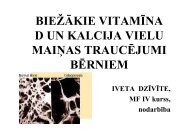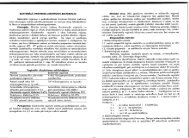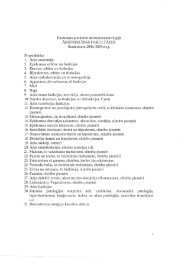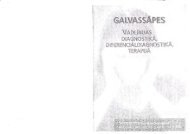PHYSICS
n - susliks.lv
n - susliks.lv
- No tags were found...
Create successful ePaper yourself
Turn your PDF publications into a flip-book with our unique Google optimized e-Paper software.
Chapter 5. MECHANOBIOLOGY<br />
..... .111 lLE _IMI!'~ •<br />
Mechanobiology is a branch of biophysics that studies the<br />
effects of external mechanical factors on living organisms and<br />
their ability to respond to these factors (to provide mechanoreception).<br />
5.1. MECHANORECEPTION<br />
Mechanoreceptors are specialized sensory formations which<br />
convert mechanical stimuli into the activity of neural cells. The<br />
mechanoreceptors can respond to different mechanical stimuli<br />
such as tactile sensitivity (response to touch, pressure, and vibration),<br />
vestibuloreception (control of equilibrium), and proprioception<br />
(coordination of the relative positions of various parts<br />
of the body).<br />
5.1.1. Tactile Sensitivity<br />
Vision. The human eye has at most 200,000 cones per square millimeter.<br />
Hawks, who must spot small prey from the sky, possess about five<br />
times as many as humans; they can see details at distance two or three<br />
times farther than humans<br />
There are a number of mechanoreceptors in the skin: free<br />
ending of afferent fibers, Meissner's corpuscles, Pacinian corpuscles,<br />
Merkel's disks, Krause's end-bulbs, and Ruffini corpuscles. Many<br />
vertebrates also use specialized hairs, vibrissae, such as those<br />
around a seal's muzzle or car's whiskers, which heighten the<br />
sense of touch. Vibrissae bend in contact with a solid object.<br />
Usually mechanoreceptors induce a change in the ion permeability<br />
of receptor cell membranes inducing an electrical signal, the<br />
receptor potential, which is transmitted to the brain. An example<br />
of mechanoreceptors is depicted in fig. 5.1.<br />
5.1.2. The Vestibular System<br />
Vestibuloreception is the response to a change in rotary acceleration<br />
and deceleration and the direction of displacement in<br />
space. Such a response is used by humans and other animals to<br />
control their body posture and locomotion. The vestibular system<br />
is located in the inner ear, or labyrinth, and consists of three<br />
semicircular canals located at right angles to each other and<br />
a pair of saclike structures called the utricle and saccule (fig. 5.2).<br />
33






